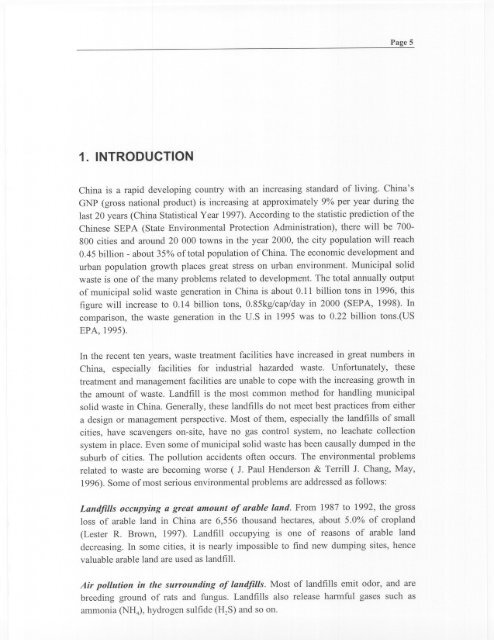a case study of municipal solid waste management in the ... - lumes
a case study of municipal solid waste management in the ... - lumes
a case study of municipal solid waste management in the ... - lumes
Create successful ePaper yourself
Turn your PDF publications into a flip-book with our unique Google optimized e-Paper software.
Page 51. INTRODUCTIONCh<strong>in</strong>a is a rapid develop<strong>in</strong>g country with an <strong>in</strong>creas<strong>in</strong>g standard <strong>of</strong> liv<strong>in</strong>g. Ch<strong>in</strong>a' sGNP (gross national product) is <strong>in</strong>creas<strong>in</strong>g at approximately 9% per year dur<strong>in</strong>g <strong>the</strong>last 20 years (Ch<strong>in</strong>a Statistical Year 1997). Accord<strong>in</strong>g to <strong>the</strong> statistic prediction <strong>of</strong> <strong>the</strong>Ch<strong>in</strong>ese SEP A (State Environmental Protection Adm<strong>in</strong>istration), <strong>the</strong>re will be 700-800 cities and around 20 000 towns <strong>in</strong> <strong>the</strong> year 2000, <strong>the</strong> city population will reach0.45 billion - about 35% <strong>of</strong> total population <strong>of</strong> Ch<strong>in</strong>a. The economic development andurban population growth places great stress on urban environment. Municipal <strong>solid</strong><strong>waste</strong> is one <strong>of</strong> <strong>the</strong> many problems re1ated to development. The total annually output<strong>of</strong> <strong>municipal</strong> <strong>solid</strong> <strong>waste</strong> generation <strong>in</strong> Ch<strong>in</strong>a is about 0.11 billion tons <strong>in</strong> 1996, thisfigure will <strong>in</strong>crease to 0.14 billion tons, 0.85kg/cap/day <strong>in</strong> 2000 (SEPA, 1998). Incomparison, <strong>the</strong> <strong>waste</strong> generation <strong>in</strong> <strong>the</strong> u.S <strong>in</strong> 1995 was to 0.22 billion tons.(DSEPA, 1995).In <strong>the</strong> recent ten years, <strong>waste</strong> treatment facilities have <strong>in</strong>creased <strong>in</strong> great numbers <strong>in</strong>Ch<strong>in</strong>a, especially facilities for <strong>in</strong>dustrial hazarded <strong>waste</strong>. Dnfortunately, <strong>the</strong>setreatment and <strong>management</strong> facilities are unable to cope with <strong>the</strong> <strong>in</strong>creas<strong>in</strong>g growth <strong>in</strong><strong>the</strong> amount <strong>of</strong> <strong>waste</strong>. Landfill is <strong>the</strong> most common method for handl<strong>in</strong>g <strong>municipal</strong><strong>solid</strong> <strong>waste</strong> <strong>in</strong> Ch<strong>in</strong>a. Generally, <strong>the</strong>se landfills do not meet best practices from ei<strong>the</strong>ra design or <strong>management</strong> perspective. Most <strong>of</strong> <strong>the</strong>m, especially <strong>the</strong> landfills <strong>of</strong> smallcities, have scavengers on-site, have no gas controi system, no leachate collectionsystem <strong>in</strong> place. Even some <strong>of</strong> <strong>municipal</strong> <strong>solid</strong> <strong>waste</strong> has been causally dumped <strong>in</strong> <strong>the</strong>suburb <strong>of</strong> cities. The pollution accidents <strong>of</strong>ten occurs. The environmental problemsre1ated to <strong>waste</strong> are becom<strong>in</strong>g worse ( 1. Paul Henderson & Terrill J. Chang, May,1996). Some <strong>of</strong> most serious environmental problems are addressed as follows:Landfills occupy<strong>in</strong>g a great amount <strong>of</strong> arable land. From 1987 to 1992, <strong>the</strong> grossloss <strong>of</strong> arable land <strong>in</strong> Ch<strong>in</strong>a are 6,556 thousand hectares, about 5.0% <strong>of</strong> cropland(Lester R. Brown, 1997). Landfill occupy<strong>in</strong>g is one <strong>of</strong> reasons <strong>of</strong> arable landdecreas<strong>in</strong>g. In some cities, it is nearly impossible to f<strong>in</strong>d new dump<strong>in</strong>g sites, hencevaluable arable land are used as landfill.Air pollution <strong>in</strong> <strong>the</strong> surround<strong>in</strong>g <strong>of</strong> landfills. Most <strong>of</strong> landfills emit odor, and arebreed<strong>in</strong>g ground <strong>of</strong> rats and fungus. Landfills also release harmful gases such asammonia (NH4), hydrogen sulfide (H2S) and so on.
















